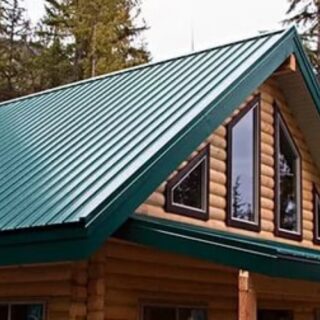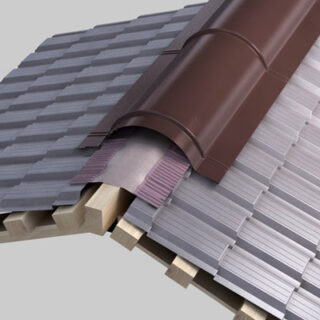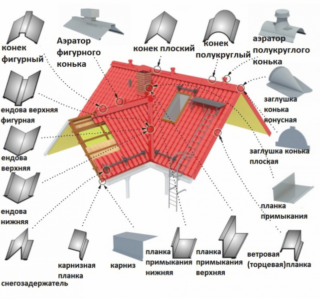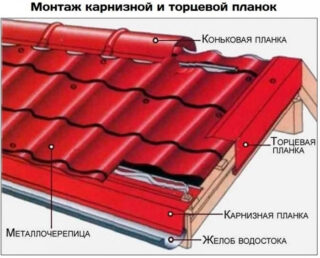The use of profiled decking as a roof covering is widely practiced in industrial, commercial and private construction. The material is distinguished by high performance characteristics, presentability, simplicity and speed of installation. In order for the roof to acquire tightness and a finished look, roof extensions from a profiled sheet are used.
Varieties of additional elements for corrugated board
Additional elements for corrugated board are divided into the following types:
- Dropper. It is a corner, fixed on the lower edge of the cornice. The lower edge descends into the drain, which ensures the drainage of condensate, melt and rainwater. Installation of a drip prevents moisture accumulation in the space under the roof. The end part is made smooth, which contributes to the free convergence of the liquid.
- End components. They are made in the form of corners with grooves along the edges. Installed at the junction of pitched decks. Subdivided into indoor and outdoor types. The inner corner for the corrugated board is set before the sheets are laid. The top profile is placed after the installation of the flooring Endows are laid in segments from bottom to top with an overlap of 15-20 cm.
- Cornice strips. This corner for profiled sheet is designed to protect the overhang from moisture, debris, insects and birds under the flooring. Fastening is carried out on the bottom edge of the lathing. Products can be simple and curly. Additional stamping serves a purely decorative function.
- End strips. They are used to close the end part of the rafters that protrude beyond the dimensions of the building. The upper edges of the corner protrude above the slope to the height of the profile. Fastening is done with nails before laying the sheets on the crate. According to the design, angular strips for corrugated board are simple and reinforced with an additional stiffener. Laying is carried out with an overlap of up to 15 cm with sealing joints.
- Junction strips. They are used to close joints between roof slopes, places of passage through chimney slopes, antenna rods and ventilation shafts. Profiles are classified into top and bottom types. The lower ones are used to seal through passages. Upper ones - for joining the flooring to the wall and decorating the connection of the building with a fence or other adjacent structure. The assembly of the wall profile for the corrugated board is carried out so that the upper parts overlap the lower ones to ensure effective drainage of water.
- The corners of the add-on. Designed for rigid fixation of the edges of the slopes after the completion of laying and screwing the sheets onto the frame. Roof corners made of corrugated board are divided into internal and external. The order of fastening - on self-tapping screws with a step of 2 waves.
- Ridge details. They are an obligatory element for pitched roofs, including the hip type. The ridge strip is installed over the ventilation gap between adjacent decks, protecting it from moisture, dirt and insects. Products are divided into flat, round and curly. The profile is complemented by a membrane type seal. As a rule, aerators are installed at the corner.
- Snow holders. The devices are used in those regions where, according to statistics, a large amount of precipitation falls in winter.The purpose of the installation is to prevent the avalanche-like descent of snow masses from the roof. By design, snow holders are tubular, lattice, point and angular. Placement is carried out in a continuous way or randomly. The fastening is carried out with long self-tapping screws on a wood base.
Common parts are manufactured using conveyor technology and have standard shapes and sizes. Curly details are more expensive, but they allow you to achieve a better result in all respects.
Decorative functions

The roof should look beautiful and attractive, giving home owners an aesthetic pleasure. A big role in achieving the desired result is given to the additional elements.
There are such decorating techniques using planks and corners:
- alternation of colors;
- non-standard colors;
- allocation of certain zones and areas;
- using a contrast effect;
- installation of stamped parts;
- chess order;
- mirror inserts.
With the right approach and the manifestation of imagination, an ordinary roof from a wall profile can be turned into a real work of art.
Consequences of the lack of additional elements

Neglect of additional details leads not only to a deterioration in the aesthetic component of the roof and the entire building as a whole. Uncovered gaps, joints and abutments look sloppy, creating a feeling of incompleteness.
Technical consequences of missing components:
- Damage and even breakage of gutters by descending snow masses;
- Rupture, deformation of parts under the influence of ice expansion.
- Penetration of insects under the roof, the occurrence of foci of infection and an unpleasant odor.
- Corrosion of the metal, followed by the weakening and destruction of the articulation points.
- Wetting wood, fraught with weakening of its strength and integrity.
- The penetration of moisture into living quarters, damage to finishes and furniture. The development of mold and mildew.
- Injury caused by falling snow from the roof.
- Trapping air in the attic space.
The lack of additional parts can cause the emergency state of the house and the need for expensive major repairs.
How to choose
When choosing accessories for roofing from a profiled sheet, you should not focus on the lowest prices. A cheap product cannot be of high quality and will not last long.
You need to pay attention to the following criteria:
- Manufacturer.
- Availability of a product certificate. You can check its authenticity on the spot by submitting a request to a search engine.
- Place of sale. It should be a solid store, not an open area.
- The appearance of the profiles. No scratches, chips, stains, distortions. Uniformity of color over the entire surface, matching the shade to the sheets.
- Packaging. The manufacturer's details are indicated on the packaging from the genuine product.
- Marking. It is applied to the back of the profiles using a laser. the symbols are clear and legible.
You need to purchase material with a small margin for the overlay and possible errors in work.
Installation technology
First of all, it is necessary to ensure compliance with safety measures:
- safety devices for work at height;
- the presence of a helmet, goggles and gloves;
- fencing and warning signs around the building;
- all tools are tied to a waist belt or structural member.
The sheets are attached to the lathing with one wave overlay on the sides and 10 cm vertically. The side parts are nailed to the boards, and the horizontal ones are screwed on. Regardless of the purpose of the parts, their screwing is carried out through a through method with a deepening into the wood structure.
Particular attention should be paid to fixing the snow holders. They experience the greatest static and dynamic loads. Based on this, they need to be screwed to the rafters for the entire thickness of the timber.










